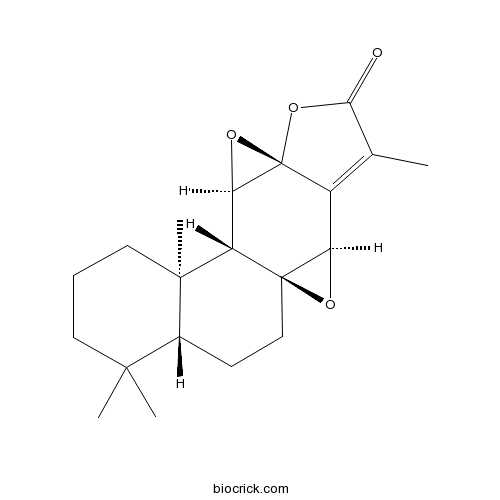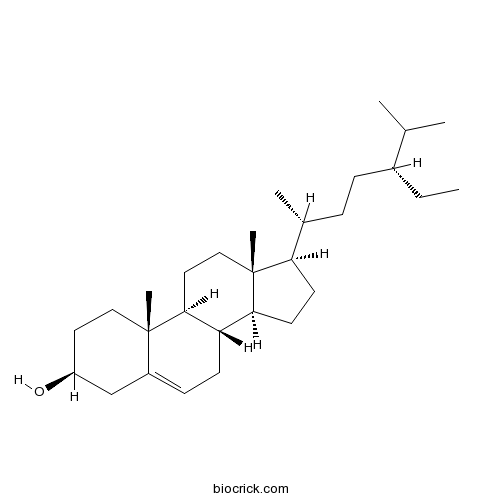Euphorbia esula
Euphorbia esula
1. The products in our compound library are selected from thousands of unique natural products; 2. It has the characteristics of diverse structure, diverse sources and wide coverage of activities; 3. Provide information on the activity of products from major journals, patents and research reports around the world, providing theoretical direction and research basis for further research and screening; 4. Free combination according to the type, source, target and disease of natural product; 5. The compound powder is placed in a covered tube and then discharged into a 10 x 10 cryostat; 6. Transport in ice pack or dry ice pack. Please store it at -20 °C as soon as possible after receiving the product, and use it as soon as possible after opening.
Natural products/compounds from Euphorbia esula
- Cat.No. Product Name CAS Number COA
-
BCN2391
Jolkinolide B37905-08-1
Instructions

-
BCN5503
Corosolic acid4547-24-4
Instructions

-
BCN7790
Euphol514-47-6
Instructions

-
BCN1015
Beta-Sitosterol83-46-5
Instructions

-
BCN4546
4-Hydroxybenzoic acid99-96-7
Instructions

[Chinese herbal medicine Euphorbia esula extract induces apoptosis and inhibits the proliferation, migration and invasion of multidrug resistant gastric carcinoma cells].[Pubmed: 29745530]
本文旨在研究中药乳浆大戟抑制多药耐药人胃癌细胞增殖、迁移、侵袭的作用,以及诱导细胞凋亡的作用及其作用通路。用不同浓度的乳浆大戟提取液处理人胃癌多药耐药 SGC7901/ADR 细胞,MTT 试验观察细胞增殖抑制情况,Hochest33528 染色荧光显微镜观察凋亡细胞核形态并测定凋亡指数,流式细胞术测定细胞凋亡率,Transwell 法检测细胞迁移能力和侵袭能力,分光光度法检测 caspase-3 和 caspase-9 的酶活性表达,Western blotting 检测细胞色素 c 的亚细胞分布。结果发现,乳浆大戟提取液对人胃癌多药耐药 SGC7901/ADR 细胞有明显的增殖抑制作用,该作用具有时间和浓度依赖性。乳浆大戟提取液处理的人胃癌多药耐药 SGC7901/ADR 细胞,凋亡指数和凋亡率均比对照组显著升高,并有时间和剂量依赖性;但添加了 caspase 酶抑制剂的细胞,凋亡指数没有明显上升。Transwell 法检测显示,乳浆大戟提取液处理后的 SGC7901/ADR 细胞,迁移能力和侵袭能力显著下降。分光光度法检测发现,乳浆大戟提取液处理后的 SGC7901/ADR 细胞中,caspase-3 和 caspase-9 表达均增加,与对照组有明显差异。Western blotting 检测显示,细胞色素 c 在线粒体中的分布下降,在细胞质中的分布上升(即细胞色素 c 从线粒体向细胞质逸出)。研究表明,乳浆大戟提取液具有抑制人胃癌多药耐药 SGC7901/ADR 细胞增殖、抑制细胞迁移侵袭和诱导细胞凋亡的作用;乳浆大戟提取液诱导细胞凋亡的作用有细胞色素 c、caspase-9 和 caspase-3 的参与,提示内源性或线粒体凋亡通路。.
Comparison of phytohormone levels and transcript profiles during seasonal dormancy transitions in underground adventitious buds of leafy spurge.[Pubmed: 28365837]
Leafy spurge (Euphorbia esula L.) is an herbaceous perennial weed that maintains its perennial growth habit through generation of underground adventitious buds (UABs) on the crown and lateral roots. These UABs undergo seasonal phases of dormancy under natural conditions, namely para-, endo-, and ecodormancy in summer, fall, and winter, respectively. These dormancy phases can also be induced in growth chambers by manipulating photoperiod and temperature. In this study, UABs induced into the three phases of dormancy under controlled conditions were used to compare changes in phytohormone and transcriptome profiles. Results indicated that relatively high levels of ABA, the ABA metabolite PA, and IAA were found in paradormant buds. When UABs transitioned from para- to endodormancy, ABA and PA levels decreased, whereas IAA levels were maintained. Additionally, transcript profiles associated with regulation of soluble sugars and ethylene activities were also increased during para- to endodormancy transition, which may play some role in maintaining endodormancy status. When crown buds transitioned from endo- to ecodormancy, the ABA metabolites PA and DPA decreased significantly along with the down-regulation of ABA biosynthesis genes, ABA2 and NCED3. IAA levels were also significantly lower in ecodormant buds than that of endodormant buds. We hypothesize that extended cold treatment may trigger physiological stress in endodormant buds, and that these stress-associated signals induced the endo- to ecodormancy transition and growth competence. The up-regulation of NAD/NADH phosphorylation and dephosphorylation pathway, and MAF3-like and GRFs genes, may be considered as markers of growth competency.
Euphorbesulins A-P, Structurally Diverse Diterpenoids from Euphorbia esula.[Pubmed: 27447736]
Aqueous ethanol extracts of powdered twigs of Euphorbia esula afforded 16 new diterpenoids, named euphorbesulins A-P. These euphorbesulins included presegetane (1-3), jatrophane (4-14), paraliane (15), and isopimarane (16) diterpenoids as well as six known analogues. Compounds 1-3 represent a rare type of presegetane diterpenoid. Their structures were determined by analysis of the spectroscopic data, and the absolute configuration of 1 was established by X-ray crystallography. Diterpenoid 7 showed low nanomolar antimalarial activity, while the remaining compounds showed only moderate or no antimalarial activity.
Apoptosis of human gastric carcinoma cells induced by Euphorbia esula latex.[Pubmed: 27053848]
To investigate the effect of Euphorbia esula (E. esula) extract in inhibiting proliferation and inducing apoptosis in SGC-7901 cells.
Phytohormone balance and stress-related cellular responses are involved in the transition from bud to shoot growth in leafy spurge.[Pubmed: 26897527]
Leafy spurge (Euphorbia esula L.) is an herbaceous weed that maintains a perennial growth pattern through seasonal production of abundant underground adventitious buds (UABs) on the crown and lateral roots. During the normal growing season, differentiation of bud to shoot growth is inhibited by physiological factors external to the affected structure; a phenomenon referred to as paradormancy. Initiation of shoot growth from paradormant UABs can be accomplished through removal of the aerial shoots (hereafter referred to as paradormancy release).
Glyphosate's impact on vegetative growth in leafy spurge identifies molecular processes and hormone cross-talk associated with increased branching.[Pubmed: 25986459]
Leafy spurge (Euphorbia esula) is a perennial weed that is considered glyphosate tolerant, which is partially attributed to escape through establishment of new vegetative shoots from an abundance of underground adventitious buds. Leafy spurge plants treated with sub-lethal concentrations of foliar-applied glyphosate produce new vegetative shoots with reduced main stem elongation and increased branching. Processes associated with the glyphosate-induced phenotype were determined by RNAseq using aerial shoots derived from crown buds of glyphosate-treated and -untreated plants. Comparison between transcript abundance and accumulation of shikimate or phytohormones (abscisic acid, auxin, cytokinins, and gibberellins) from these same samples was also done to reveal correlations.
Coordinated Expression of FLOWERING LOCUS T and DORMANCY ASSOCIATED MADS-BOX-Like Genes in Leafy Spurge.[Pubmed: 25961298]
Leafy spurge (Euphorbia esula L.) is a noxious perennial weed that produces underground adventitious buds, which are crucial for generating new vegetative shoots following periods of freezing temperatures or exposure to various control measures. It is also capable of flowering and producing seeds, but requires vernalization in some cases. DORMANCY ASSOCIATED MADS-BOX (DAM) genes have been proposed to play a direct role in the transition to winter-induced dormancy and maintenance through regulation of the FLOWERING LOCUS T (FT) gene, which also is likely involved in the vernalization process. To explore the regulation of FT and DAM during dormancy transitions in leafy spurge, the transcript accumulation of two previously cloned DAM splice variants and two different previously cloned FT genes was characterized. Under long-photoperiods (16 h light), both DAM and FT transcripts accumulate in a diurnal manner. Tissue specific expression patterns indicated the tissues with high DAM expression had low FT expression and vice versa. DAM expression is detected in leaves, stems, shoot tips, and crown buds. FT transcripts were detected mainly in leaves and flowers. Under dormancy inducing conditions, DAM and FT genes had an inverse expression pattern. Additionally, chromatin immunoprecipitation assays were performed using DAM-like protein specific antibodies to demonstrate that DAM or related proteins likely bind to cryptic and/or conserved CArG boxes in the promoter regions of FT genes isolated from endodormant crown buds. These results are consistent with the hypothesis that DAM proteins play a crucial role in leafy spurge dormancy transition and maintenance, potentially by negatively regulating the expression of FT.
The resemblance and disparity of gene expression in dormant and non-dormant seeds and crown buds of leafy spurge (Euphorbia esula).[Pubmed: 25112962]
Leafy spurge (Euphorbia esula L.) is a herbaceous perennial weed and dormancy in both buds and seeds is an important survival mechanism. Bud dormancy in leafy spurge exhibits three well-defined phases of para-, endo- and ecodormancy; however, seed dormancy for leafy spurge is classified as physiological dormancy that requires after-ripening and alternating temperature for maximal germination. Overlaps in transcriptome profiles between different phases of bud and seed dormancy have not been determined. Thus, we compared various phases of dormancy between seeds and buds to identify common genes and molecular processes, which should provide new insights about common regulators of dormancy.
Increase in ACC oxidase levels and activities during paradormancy release of leafy spurge (Euphorbia esula) buds.[Pubmed: 23625016]
The plant hormone ethylene is known to affect various developmental processes including dormancy and growth. Yet, little information is available about the role of ethylene during paradormancy release in underground adventitious buds of leafy spurge. In this study, we examined changes in ethylene evolution and the ethylene biosynthetic enzyme ACC oxidase following paradormancy release (growth induction). Our results did not show an obvious increase in ethylene during bud growth. However, when buds were incubated with 1 mM ACC, ethylene levels were higher in growing than non-growing buds, suggesting that the levels of ACC oxidase increased in growing buds. Real-time qPCR indicated that the transcript of a Euphorbia esula ACC oxidase (Ee-ACO) increased up to threefold following growth induction. In addition, a 2.5- to 4-fold increase in ACO activity was observed 4 days after decapitation, and the Ee-ACO accounted for 40 % of the total ACO activity. Immunoblot analyses identified a 36-kD Ee-ACO protein that increased in expression during bud growth. This protein was highly expressed in leaves, moderately expressed in crown buds, stems and meristems, and weakly expressed in roots and flowers. Immunolocalization of Ee-ACO on growing bud sections revealed strong labeling of the nucleus and cytoplasm in cells at the shoot apical meristem and leaf primordia. An exception to this pattern occurred in cells undergoing mitosis, where labeling of Ee-ACO was negligible. Taken together, our results indicated an increase in the levels of Ee-ACO during paradormancy release of leafy spurge that was not correlated with an increase in ethylene synthesis.


